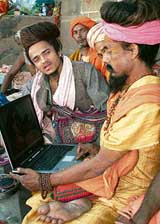
I am an avid reader of science fiction stories। And one of the very first ‘science fiction’ stories I read was titled ‘Hide and Seek’ by Sir Arthur Charles Clarke. It is about an astronaut marooned on an asteroid, trying to escape from a search party in orbit. The story goes on to tell how he escaped his pursuers by circumnavigating the asteroid.
What I vividly remember about the story is the feeling it had put in my head; about the sheer size of space and the complete insignificance of the size of one human being in comparison। The mere fact that an asteroid is bigger than an intergalactic space ship was a revelation. I almost got giddy thinking about all those galaxies and their stars with their own systems and peculiar instances of spatial phenomenon. Interestingly, the immensity of the feeling attracted me towards reading science fiction instead of pushing me away, as it does to a lot of people.
Science fiction is not a much loved genre. I’ve heard a lot of people speak with disdain about science fiction, which they tag as ‘complete fantasy’, ‘chronicles about things that are not’ and even ‘geeky fiction’. I choose a different definition, ‘Science fiction is a possible history of the future’, which is in agreement with Sir Clarke’s view. He very actively promoted the thought that science fiction should provide ideas to real researchers. He had always written hard science fiction that was based on solid scientific facts and theories. This made almost all his writing seem real and not too far away in the future. Being a futurist (which comes with being a SF writer), he is credited with thinking up the use of geo-stationary satellites for communication. But it is his other prediction that caught my imagination when I first read it; the space elevator। It is something that I’d love to see in my lifetime.
Everyone has probably heard of Asimov’s three laws. Clarke too had three laws, they have nothing to with robots but are true reflections of the person Clarke was. I paste them here, read them to understand the person he was, intelligent and humorous at the same time. Here are his three laws of prediction:
- When a distinguished but elderly scientist states that something is possible, he is almost certainly right। When he states that something is impossible, he is very probably wrong।
- The only way of discovering the limits of the possible is to venture a little way past them into the impossible.
- Any sufficiently advanced technology is indistinguishable from magic।
Among many versions of ‘first contact’, one of the most possible has been written by Sir Clarke in Childhood’s end, another very readable book। Some of his stories took science fiction writing to completely new levels; The Sentinel, is one of them. It is the story that is the inspiration for Stanley Kubrik’s magnum opus ‘2001: A space Odyssey’, and also perhaps Clarke’s most famous story. Among his other writings, the Rama series (with Gentry Lee) is worth mentioning, for the immensity of its sweep of the universe and the intensity of its storyline.
I intended this piece to be a sort of obituary of Sir Clarke, but I guess I ended up writing about what I felt about what he wrote, and things he thought about. Nonetheless, if you want to know about his life, you can always wiki।
I had hoped his ashes will follow Gene Roddenberry’s to space. But he lies buried in Sri Lanka, dreaming eternally. The world is sure to remember him when the first extra terrestrials land, till then; our ( all science fiction fans) remembrance will have to suffice.
I thought up an epitaph for his gravestone:
It is only a matter of a couple of billion years till his true realm of stars comes to claim him, till then, here he lies; In Transit.























